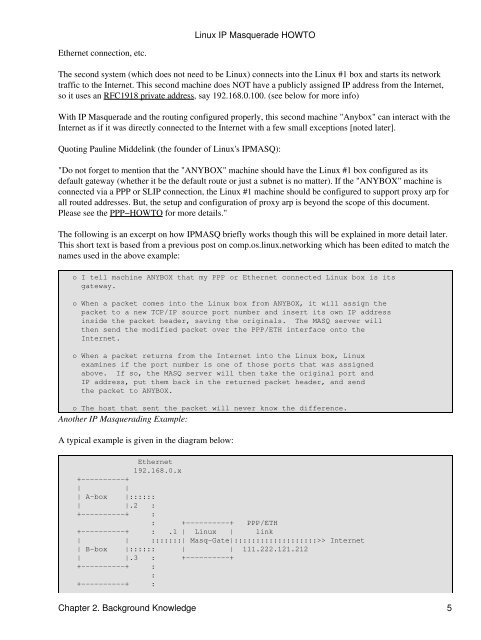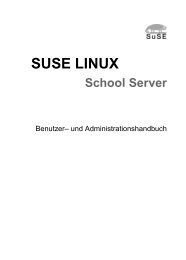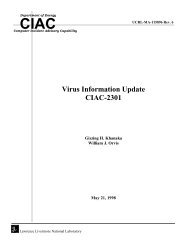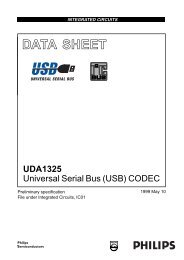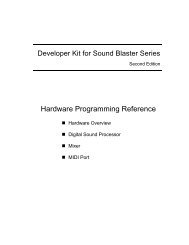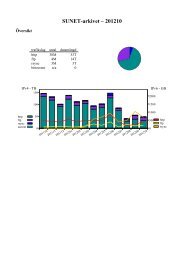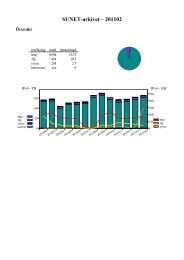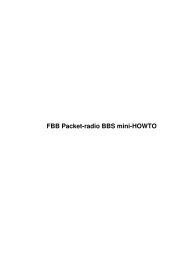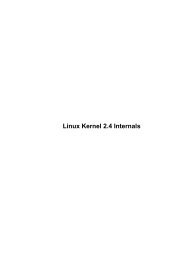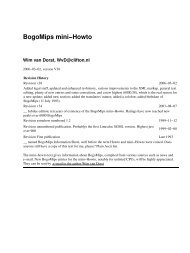Linux IP Masquerade HOWTO - The Linux Documentation Project
Linux IP Masquerade HOWTO - The Linux Documentation Project
Linux IP Masquerade HOWTO - The Linux Documentation Project
Create successful ePaper yourself
Turn your PDF publications into a flip-book with our unique Google optimized e-Paper software.
Ethernet connection, etc.<br />
<strong>The</strong> second system (which does not need to be <strong>Linux</strong>) connects into the <strong>Linux</strong> #1 box and starts its network<br />
traffic to the Internet. This second machine does NOT have a publicly assigned <strong>IP</strong> address from the Internet,<br />
so it uses an RFC1918 private address, say 192.168.0.100. (see below for more info)<br />
With <strong>IP</strong> <strong>Masquerade</strong> and the routing configured properly, this second machine "Anybox" can interact with the<br />
Internet as if it was directly connected to the Internet with a few small exceptions [noted later].<br />
Quoting Pauline Middelink (the founder of <strong>Linux</strong>'s <strong>IP</strong>MASQ):<br />
"Do not forget to mention that the "ANYBOX" machine should have the <strong>Linux</strong> #1 box configured as its<br />
default gateway (whether it be the default route or just a subnet is no matter). If the "ANYBOX" machine is<br />
connected via a PPP or SL<strong>IP</strong> connection, the <strong>Linux</strong> #1 machine should be configured to support proxy arp for<br />
all routed addresses. But, the setup and configuration of proxy arp is beyond the scope of this document.<br />
Please see the PPP−<strong>HOWTO</strong> for more details."<br />
<strong>The</strong> following is an excerpt on how <strong>IP</strong>MASQ briefly works though this will be explained in more detail later.<br />
This short text is based from a previous post on comp.os.linux.networking which has been edited to match the<br />
names used in the above example:<br />
o I tell machine ANYBOX that my PPP or Ethernet connected <strong>Linux</strong> box is its<br />
gateway.<br />
o When a packet comes into the <strong>Linux</strong> box from ANYBOX, it will assign the<br />
packet to a new TCP/<strong>IP</strong> source port number and insert its own <strong>IP</strong> address<br />
inside the packet header, saving the originals. <strong>The</strong> MASQ server will<br />
then send the modified packet over the PPP/ETH interface onto the<br />
Internet.<br />
o When a packet returns from the Internet into the <strong>Linux</strong> box, <strong>Linux</strong><br />
examines if the port number is one of those ports that was assigned<br />
above. If so, the MASQ server will then take the original port and<br />
<strong>IP</strong> address, put them back in the returned packet header, and send<br />
the packet to ANYBOX.<br />
o <strong>The</strong> host that sent the packet will never know the difference.<br />
Another <strong>IP</strong> Masquerading Example:<br />
A typical example is given in the diagram below:<br />
<strong>Linux</strong> <strong>IP</strong> <strong>Masquerade</strong> <strong>HOWTO</strong><br />
Ethernet<br />
192.168.0.x<br />
+−−−−−−−−−−+<br />
| |<br />
| A−box |::::::<br />
| |.2 :<br />
+−−−−−−−−−−+ :<br />
: +−−−−−−−−−−+ PPP/ETH<br />
+−−−−−−−−−−+ : .1 | <strong>Linux</strong> | link<br />
| | :::::::| Masq−Gate|:::::::::::::::::::>> Internet<br />
| B−box |:::::: | | 111.222.121.212<br />
| |.3 : +−−−−−−−−−−+<br />
+−−−−−−−−−−+ :<br />
:<br />
+−−−−−−−−−−+ :<br />
Chapter 2. Background Knowledge 5


